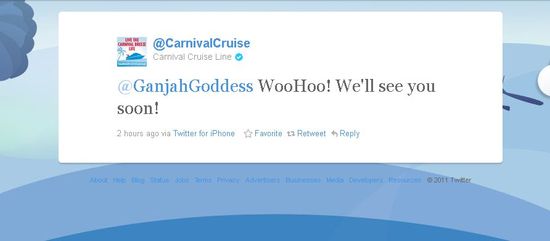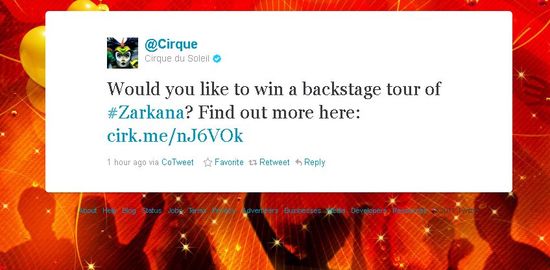How many times have you heard that being successful in using social media is all about engagement? I hate to be the bearer of bad news, but it isn't. For a consumer that is going on Twitter to complain about how their mobile phone doesn't have coverage, they don't want to be "engaged" with your brand … they want you to fix your coverage. Engagement, as social media experts often think about it, is about having a conversation with customers as if you have a relationship with them. Sometimes you do, and that's great. Yet often you may be communicating from a nonexistent place of familiarity and you'd be much better off focused on ADDING VALUE instead of trying to offer engagement.
I recently experienced two very real examples of this with two brands which on the surface both seem to be using Twitter well for engagement. In reality, they offer a perfect contrast of what to do and what NOT to do when building your strategy for engaging with customers. Let's start with the example of what not to do:
CARNIVAL CRUISE LINES
Carnival has more than 36,000 fans and lots of direct engagement. They have lots of @replies to individuals, and they help customers when someone tweets about an issue or problem. So what else could they be doing?
- Separate customer service from main Twitter account. By having a stream of replies only, they miss the opportunity to use the channel more for news and special offers (which have more value for any potential cruiser). Ironically, Carnival has a separate Twitter account for customer service (@CCLSupport), yet they are not actively trying to move customer support related issues over to that account. Even the simple step of directly responding to people who tweet about @CarnivalCruise from that account instead of the main one could help.
- Turn Tweeters into advocates by offering real value. When people tweet about going on vacation, why not offer them some incentive to surprise them and keep them talking instead of just telling them to have a nice time? Even something as simple and zero-cost as offering them priority check-in for their cruise would likely delight many of those people tweeting about the experience … and you already know they will tell their entire network on Twitter. I want my friends to wish me a great cruise … I'd love for Carnival to actually give me something to make that really happen.
- Follow your customers to enable direct contact. If you are going to use a Twitter as a direct channel to communicate with customers, they why wouldn't you follow every one of your customers who say that they are going on one of your cruises? Currently Carnival follows less than 1% of their followers back. Doing so not only offers them a direct channel to get in touch with you, it will also help to take some of the 1-to-1 conversations happening on Twitter out of the conversation stream and turn them into private conversations so they don't annoy those following your account but not involved in that conversation.
CIRQUE DU SOLEIL
In contrast, Cirque Du Soleil has more than 225,000 followers on Twitter. More importantly, their stream on Twitter includes many special offers, exclusive events and lots of things that anyone who is interested in any one of Cirque's 22 productions around the world would want to know about – along with direct replies to consumers. What makes their Twitter account work so well?
- Create a sense of exclusivity. Throughout the account, Cirque shares photos from exclusive events, links to interesting special offers and generally does a good job of including lots of content that their followers would probably be interested in seeing. More importantly, they leverage the specific value of Twitter to share some of those deals on a platform that is likely to be shared.
- Follow and engage your followers. While Cirque "only" follows less than 20% of the people who follow them, chances are many of their followers are not necessarily engaged Twitter users, so the more important number to consider is that they have a direct connection with more than 35,000 Twitter users. This has a very high value because those people can connect with Cirque directly and become advocates.
- Engage influencers beyond Twitter. Cirque also wins by going beyond Twitter. Over the past several years, I have met people who work in social media at Cirque at events and been lucky enough to be invited to attend several of their shows. Each time, I have had an amazing experience and often shared it through Twitter.
























Hey Rohit!
Thank you for this great post. Honestly I still wonder if Twitter is worth the time. I have the feeling that there are so many spammers on this platform. When I look at my account I receive sales pitches almost every minute.
The same problem with Facebook. I just listened to a webinar with a guy who was able to build a FanPage with 500+k fans in under 18 months. During the webinar he posteted a message and refreshed after one minute. After refreshing he had generated about 20 comments and 50 likes. I think this is a pretty bad result considering the 500+k following.
Due to this low response-rates I wonder whether it is still possible to use this Social Media Sites efficiently in the future.
Would be great to hear your thoughts!
Christian
I agree that you should separate your technical support to your twitter account. Since a complaint when answered shouldn’t be posted in the wall. Bad publicity and at the same time some followers may be uncomfortable to get those kind of tweets.
This is an exceptional article that highlights what’s is often missed by businesses rushing to get in on the social media band wagon. I totally agree with the author. These social sites are not the “be all to end all” in business or marketing. Businesses have to create a well though out comprehensive strategy to get the most bang for the bucks. This not only goes for social media, but also for all advertising venues. The more cohesive their plan is, the greater their results and return on investment.
I really liked this post because it discussed specific ways that companies should use their Twitter accounts. A lot of time, companies overlook that they should be providing an incentive, or value to to customer. Even useful or valuable information is an easy way to give your followers a reason to look for you.
@grassrootsinc
The Carnival tweet made me laugh. Although they had the right idea with trying to engage customers, Cirque Du Soleil really hit it out of the ball park. Incredible how much of a difference there can be in so few characters. Most important thing to take away: make the audience want to search for more about you beyond twitter. If they do that, then you have had a successful twitter capmaign
Sorry for the multiple comments! please delete all (except my first)
very cool post! thnks alot!
Really like this article – particularly about customer service and how to better use Twitter for those needs. Thanks for the insights.
Yantram specialize in EBay template design services. You can use our services for your EBay template; customers will be impressed by the professional appearance of your listings
Virtual Assistance’ and ‘Virtual Assistant’ are terms not familiar with many people. People who are not aware of virtuality still stick to traditional offices where an assistant enters in the mornings, makes coffee, handles mail, answers telephones,
Great mini case study! I do think it’s ironic that you don’t have Twitter as a log in option. I really thought it would be cool to connect with some of the other commentators about this post in particular—you know build a sense of community.
twitter.com/sylvanmedia
Cool article, especially about the tweeters. that is just to funny. Thank you for the laugh, you made my night.
I’m not sure about “following your customers to create engagement”. I work with a bunch of brands many of whom have abut 20,000 followers. There is no way that they can keep up a personal conversatioon with all those people even if they do talk back the odd time. There is also no real point just following people for the sake of following them either
I agree with Christian, I think social media is by and large full of spams and copy+paste messages. I would actually prefer to engage with customers and tell them we are there rather than always seem aloof and create an air of superiority over other brands (though that marketing has its own place in the system).
familiarity and you’d be much better off focused on ADDING VALUE instead of trying to offer engagement.
familiarity and you’d be much better off focused on ADDING VALUE instead of trying to offer engagement.
customer service is better than social media, more targeted and specific traffic for the site
This article is really the one that I needed. I really learned a lot by reading the whole content. Thanks for this.
This begs a bigger question – how do these companies monitor these comments/complaints? Surely it’s implausible to employ a team of people to monitor and respond and it can’t be left down to the customer service/technical team to manually keep a check? There must be intelligent tools that allow automated monitoring and responding?
Really interesting article, very much to learn from it. Thanks
Buy or sell new and used products in Pakistan with our free classifies ads portal.
http://www.classify.pk
Nice blog,I really like the way you have written this post.Keep it up.I will re visit your blog soon.
https://www.potentiamed.com